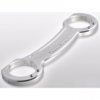ST Gui
240Robert
A pulled hamstring and bone spurs affect walking. Improvement on either of those areas will improve walking. But not in all areas. In the broadest sense you're correct but one correcting one problem doesn't do much if anything for the other.mlheck said:No, preatty much in all area's. The bike is much more stable when the forks are supporting it properly.
Not exactly. The flex occurs between the lower triple clamp and the axle. In the video posted the bending or flexing was most apparent midway between those two points IIRC. The flexing of the inner tube (fork tube) was also affected by movement of the 'outer' tube (fork leg). Whatever was moving the fork tubes themselves couldn't be the only part of the equation.caldercay said:Hmmmm. If each inner tube is itself "bending", a fork brace mounted across the outer tubes wont stop the inner tube "bending".
Stabilizing the fork legs at the top would add stability to the entire fork assembly. So it might not stop the flex but it's obvious how it could decrease it.
As to stiction it also seems very possible if not likely that a fork tube's flexing at the point of entry into the leg could load the fork seal more than when not flexing causing the seal/tube interaction to bind increasing stiction momentarily.
That comes back to fundamental questions— how much flex is present in any given make/model of bike and will a fork brace make a difference and will that rider be able to appreciate it.
If you've tried a brace and felt no improvement and even a decrease in handling, I don't doubt your observations but see them relevant to you and your individual bike. But I apply the same to those who have tried one and felt an improvement.
In the absence of observable results from objective controlled testing we're left with few data points and rank conjecture. Placebo effect? Maybe. Maybe not. Geeze this is fun.

